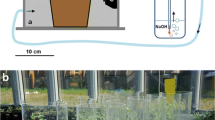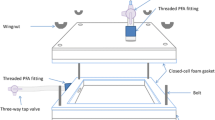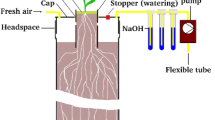Abstract
The rhizosphere is a major sink for photo-assimilated carbon and quantifying inputs into this sink is one of the main goals of rhizosphere biology as organic carbon lost from plant roots supports a higher microbial population in the rhizosphere compared to bulk soil. Two fundamentally different14CO2 labelling strategies have been developed to estimate carbon fluxes through the rhizosphere — continuous feeding of shoots with labelled carbon dioxide and pulse-chase experiments. The biological interpretation that can be placed on the results of labelling experiments is greatly biased by the technique used. It is the purpose of this paper to assess the advantages, disadvantages and the biological interpretation of both continuous and pulse labelling and to consider how to partition carbon fluxes within the rhizosphere.
Similar content being viewed by others
References
Balesdent J and Balabane M 1992 Maize root-derived soil organic carbon estimated by natural13C abundance. Soil Biol. Biochem. 24, 97–101.
Bowen G D and Rovira A D 1992 The rhizosphere, the hidden half.In Plant Roots, the Hidden Half. Eds. YWaisel, AEshel and UKafkafi. pp 641–669. Marcel Dekker, New York.
Bushby H V, Vallis I and Myers R J K 1992 Dynamics of C in pasture grass (Panicum maximum var. Trichoglume)-soil system. Soil Biol. Biochem. 24, 381–388.
Cheng W, Coleman D C, Carroll C R and Hoffman C A 1993 In situ measurement of root respiration and soluble C concentrations in the rhizosphere. Soil Biol. Biochem. 25, 1189–1196.
Curl E A and Truelove B 1986 The Rhizosphere. Springer-Verlag, Berlin.
Dormaar J F and Sauerbeck D R 1983 Seasonal effects on photoassimilated carbon-14 in the root system of blue grama and associated soil organic matter. Soil Biol. Biochem. 15, 475–479.
Ehleringer J R 199113C/12C fractionation and its utility in terrestrial plant studies.In Carbon Isotope Techniques. Eds. D CColeman and BFry. pp 187–200. Academic Press, San Diego.
Gregory P J and Atwell B J 1991 The fate of carbon in pulse-labelled crops of barley and wheat. Plant and Soil 136, 205–213.
Hale M G, Foy C L and Shay F L 1971 Factors affecting root exudation. Adv. Agron. 23, 89–109.
Harris D, Pacovsky R S and Paul E A 1985 Carbon economy of soybean-Rhizobium-Glomus associations. New Phytol. 101, 427–440.
Harris D and Paul E A 1991 Techniques for examining the carbon relationships of plant-microbial symbiosis.In Carbon Isotope Techniques. Eds. D CColeman and BFry. Academic Press, San Diego. pp 39–52.
Helal H M and Sauerbeck D R 1984 Influence of plant roots on C and P metabolism in soil. Plant and Soil 76, 175–182.
Helal H M and Sauerbeck D R 1986 Effect of plant roots on carbon metabolism of soil microbial biomass. Z. Pflanzenernaehr. Bodenkd. 149, 181–188.
Holden J 1975 The use of nuclear staining to assess rates of cell death in the cortices of cereal roots. Soil Biol. Biochem. 18, 445–449.
Jensen B 1993 Rhizodeposition by14CO2-pulse-labelled spring barley grown in small field plots on sandy loam. Soil Biol. Biochem. 25, 1553–1559.
Johansson G 1992 Release of organic C from growing roots of meadow fescue (Festuca pratensis L.). Soil Biol. Biochem. 24, 427–433.
Johansson G 1993 Carbon distribution in grass (Festuca pratensis L.) during regrowth after cutting-utilization of stored and newly assimilated carbon. Plant and Soil 151, 11–20.
Johnen B G and Sauerbeck D R 1977 A tracer technique for measuring growth, mass and microbial breakdown of plant roots during vegetation. Soil Organ. Comp. Ecosyst. Ecol. Bull. 25, 366–373.
Keith H, Oades J M and Martin J K 1986 Input of carbon to soil from wheat plants. Soil Biol. Biochem. 18, 445–449.
Kucey R M and Paul E A 1982 Carbon flow, photosynthesis and N2 fixation in mycorrhizal and nodulated faba beans (Vicia faba L.). Soil Biol. Biochem. 14, 407–412.
Lambers H 1987 Growth, respiration, exudation and symbiotic associations: the fate of carbon translocated to the roots.In Root Development and Function. Eds. P JGregory, J VLake and D ARose. pp 125–145. Cambridge University Press, Cambridge.
Liljeroth E, VanVeen J A and Miller H J 1990 Assimilate translocation to the rhizosphere of two wheat lines and subsequent utilization by rhizosphere microorganisms at two soil nitrogen concentrations. Soil Biol. Biochem. 22, 1015–1021.
Lynch J M and Whipps J M 1990 Substrate flow in the rhizosphere. Plant and Soil 129, 1–10.
Martens R 1990 Contribution of rhizodeposits to the maintenancy and growth of soil microbial biomass. Soil Biol. Biochem. 22, 141–147.
Martin J K 197514C-labelled material leached from the rhizosphere of plants supplied continuously with14CO2. Soil Biol. Biochem. 7, 395–399.
Martin J K 1976 The chemical nature of the carbon-14-labelled organic matter released into soils from growing wheat roots.In Soil Organic Matter Studies, Proceedings of a Symposium organized by the IAEA FAO 1, 197–203.
Martin J K 1977 Factors influencing the loss of organic carbon from wheat roots. Soil Biol. Biochem. 9, 1–7.
Martin J K and Kemp J R 1980 Carbon loss from roots of wheat cultivars. Soil Biol. Biochem. 12, 551–554.
Martin J Y and Kemp J R 1986 The measurement of C transfers within the rhizosphere of wheat grown in field plots. Soil Biol. Biochem. 18, 103–107.
Martin J K and Merckx R 1992 The partitioning of photosynthetically fixed carbon within the rhizosphere of mature wheat. Soil Biol. Biochem. 24, 1147–1156.
Mary B, Mariotti A and Morel J L 1992 Use of13C variations at natural abundance for studying the biodegradation of root mucilage, roots, and glucose in soil. Soil Biol. Biochem. 24, 1065–1072.
Mary B, Fresneau C, Morel J L and Mariotti A 1993 C-cycling and N-cycling during decomposition of root mucilage, roots and glucose in soil. Soil Biol. Biochem. 25, 1005–1014.
Meharg A A and Killham K 1988 A comparison of carbon flow from pre-labelled and pulse-labelled plants. Plant and Soil 112, 225–231.
Meharg A A and Killham K 1989 Distribution of assimilated carbon within the plant and rhizosphere ofLolium perenne: Influence of temperature. Soil Biol. Biochem. 21, 487–489.
Meharg A A and Killham K 1990a Carbon distribution within the plant and rhizosphere in laboratory and field-grownLolium perenne at different stages of development. Soil Biol. Biochem. 22, 471–477.
Meharg A A and Killham K 1990b Carbon distribution within the plant and rhizosphere forLolium perenne subjected to anaerobic soil conditions. Soil Biol. Biochem. 22, 643–647.
Merckx R and Martin J K 1987 Extraction of microbial biomass components from rhizosphere soils. Soil Biol. Biochem. 19, 371–376.
Merckx R, DenHartog A and VanVeen J A 1985 Turnover of root-derived material and related microbial biomass formation in soils of different texture. Soil Biol. Biochem. 17, 565–569.
Merckx R, VanGinkel J H, Sinnaeve J and Cremers A 1986 Plant induced changes in the rhizosphere of maize and wheat I. Production and turnover of root-derived material in the rhizosphere of wheat. Plant and Soil 96, 85–93.
Milchunas D G, Lauenroth W K, Singh J S, Cole C V and Hunt H W 1985 Root turnover and production by14C dilution: implications of carbon partitioning in plants. Plant and Soil 88, 353–365.
Minchin P E H and McNaughton G S 1984 Exudation of recently fixed carbon by non-sterile roots. J. Exp. Bot. 35, 74–82.
Norton J M, Smith J L and Firestone M K 1990 Carbon flow in the rhizosphere of ponderosa pine seedlings. Soil Biol. Biochem. 22, 449–455.
Pang P C and Paul E A 1980 Effects of vesicular-arbuscular mycorrhiza on14C and15N distribution in nodulated faba beans. Can. J. Soil Sci. 60, 241–250.
Rovira A D 1969 Diffusion of carbon compounds away from wheat roots. Aust. J. Biol. Sci. 22, 1287–1290.
Rovira A D, Foster R C and Martin J K 1978 Origin, nature and nomenclature of the organic materials in the rhizosphere.In The Soil-Root Interface. Eds. J LHarley and RScott-Russell. pp 1–4. Academic Press, London.
Scott-Russell R 1978 Plant Root Systems. McGraw and Hill, London.
Shepherd T and Davies H V 1993 Carbon loss from the roots of for-age rape (Brassica napus L.) seedlings following pulse-labelling with14CO2. Ann. Bot. 72, 155–163.
Snellgrove R C, Splittstoesser W E, Stribley D P and Tinker P B 1982 Distribution of carbon and the demands of the fungal symbiont in leek plants with vesicular-arbuscular mycorrhizas. New Phytol. 92, 75–87.
Swinnen J, VanVeen J A and Merckz R 1994a14C pulse-labelling of field grown spring wheat: an evaluation of its use in rhizosphere carbon budget estimations. Soil Biol. Biochem. 26, 161–170.
Swinnen J, VanVeen J A and Merckz R 1994b Rhizosphere carbon fluxes in field-grown spring wheat: model calculations based on14C partitioning after pulse labelling. Soil Biol. Biochem. 26, 171–182.
Warembourg F R and Paul E A 1973 The use of14CO2 canopy techniques for measuring carbon transfer through the plant-soil system. Plant and Soil 38, 331–345.
Warembourg F R, Estelrich D H and Lafont F 1990 Carbon partitioning in the rhizosphere of an annual and perennial species of bromegrass. Symbiosis 9, 29–36.
Warembourg F R and Kummerow J 1991 Photosynthesis/ translocation studies in terrestrial ecosystems.In Carbon Isotope Techniques. Eds. D CColeman and BFry. pp 11–38. Academic Press, San Diego.
Whipps J M 1984 Environmental factors affecting the loss of carbon from the roots of wheat and barley seedlings. J. Exp. Bot. 35, 767–773.
Whipps J M 1987 Carbon loss from the roots of tomato and pea seedlings grown in soil. Plant and Soil 103, 95–100.
Whipps J M and Lynch J M 1983 Substrate flow and utilization in the rhizosphere of cereals. New Phytol. 95, 605–623.
Author information
Authors and Affiliations
Rights and permissions
About this article
Cite this article
Meharg, A.A. A critical review of labelling techniques used to quantify rhizosphere carbon-flow. Plant Soil 166, 55–62 (1994). https://doi.org/10.1007/BF02185481
Received:
Accepted:
Issue Date:
DOI: https://doi.org/10.1007/BF02185481




